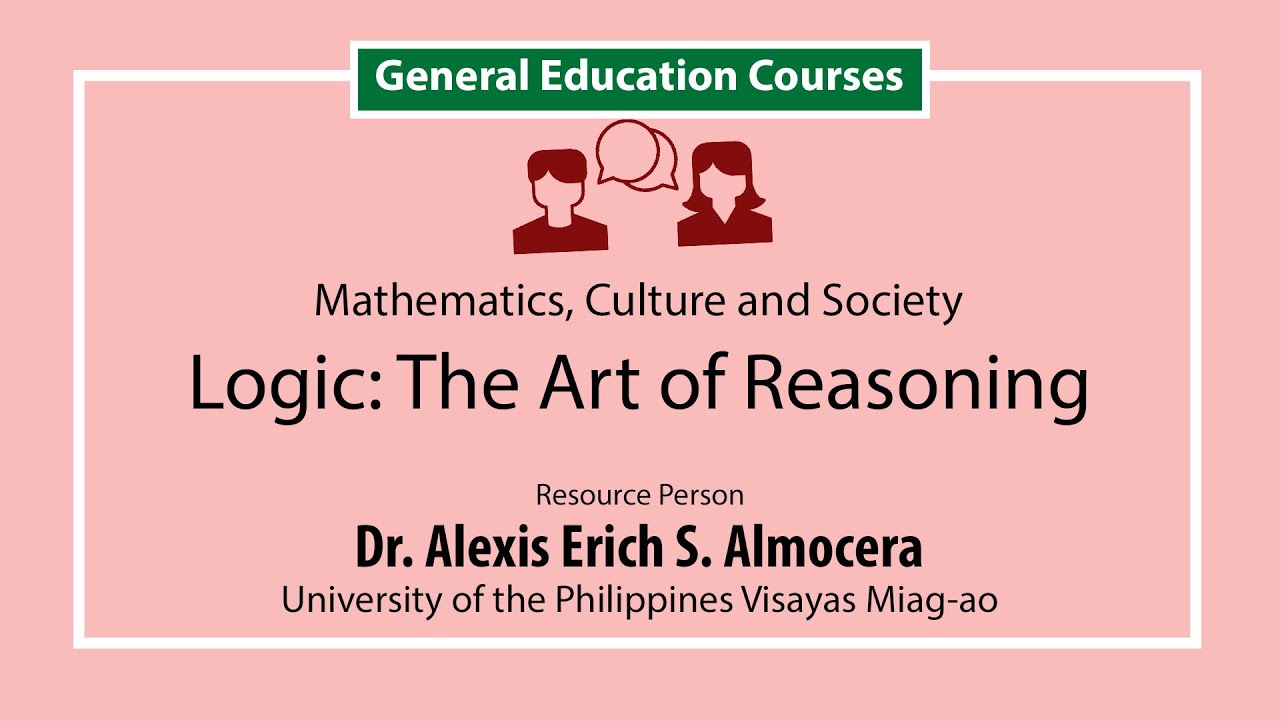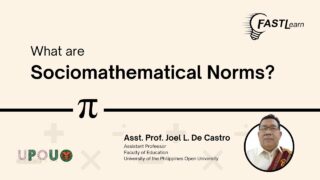Logic: The Art of Reasoning | Dr. Alexis Erich S. Almocera
Logic: The Art of Reasoning
Mathematics, Culture and Society
Dr. Alexis Erich S. Almocera
Good day everyone! I would like to begin with a few historically inaccurate quotes.
“The actual building of roads devoted to motor cars will not occur in the future.” In 2019, we have roads for motorcades, motorcycles and bikes.
“The abdomen, the chest and the brain will forever be shut from the intrusion of the wise and humane surgeon.” However this is now possible thanks to modern medicine.
“Television won’t be able to hold on to any market. People will soon get tired of staring at a plywood box every night.” But in 2019, we have things like Facebook, Netflix, YouTube and the like.
“Whatever happens in Vietnam, I can conceive of nothing except military victory.” That’s coming from a US president and, sadly, the US was on the losing side of Vietnam.
“When the President does it, that means that is not illegal.” But we have measures and laws in place that justify grounds for impeachable cases.
So you see, there are statements that used to be true before but are now false, and it is important in the modern age to determine whether what you’ve heard or seen is true or false. So that’s why it’s important to have logical skills?
The science of how to evaluate arguments and reasoning is called logic. And the process of evaluation which uses logic to separate truth from falsehood, fact from fiction, and reasonable from unreasonable beliefs is what we call critical thinking.
There are a number of reasons why logic can benefit your lives. It can improve your ability to assess the truth specifically of mathematical statements. Having a good background on logic will help you build communication skills, as well as a capacity for abstract reasoning. Needless to say, it is very important when you do a lot of mathematics. Logic can help you overcome linguistics habits and fallacies. Logic can also promote critical thinking and, most importantly, it will help you build confidence to solve any problems, whether it is mathematical or otherwise.
And, we will start with statements. This is the foundation of everything that is logic. So, I want you to determine if the following statements are true or false:
Today is Thursday.
Three plus four equals seven.
Two plus two equals five.
Are you hungry?
Infinity Wars is the greatest film of all time.
x is less than five.
Lovely!
Read the last line of Macbeth.
Seven is a lucky number.
So, which of these statements are true or false? The ones that are checked are a declarative and objective statements, and, regardless of whether you can say it’s true or false, the statement is either true or false but it’s not both. The ones in the check marks are what you call mathematical statements. A mathematical statement is a declarative statement that can be assigned a truth value, and be classified as a true or false statement but not both. Questions, exclamations, imperatives are not declarative so they are not mathematical statements, and opinions are not objective. Opinions might be true for one but may be believed to be false for another. So, opinions are not mathematical statements.
So, now it’s your turn. I would like you to determine which of the following statements are mathematical statements.
Here are the answers. The ones in checkmarks are mathematical statements.
Let me reiterate. They should be declarative, objective, and you can either to label it as true or false but not both. So those marked check are mathematical statements.
Now, mathematical statements convey ideas, and those that convey single ideas are what you call simple statements. We denote these with lowercase letters, for example we can let small lowercase p stand for the statement “102 is an even number”. Now, we don’t care if it’s going to be true or false as long as it is either true or false but not both. With simple statements you can connect them together into compound statements such as the sentence “it is 5:00 PM and I am working”. You connect these simple statements by connectives, so you can have a conjunction: “p and q”, a disjunction: “p or q”, a conditional which is in the form “if p, then q”, a biconditional which reads “p if and only if q”, or a negation which is simply “not p”.
Each compound statement has its own symbolic notation as you can see in the slides. So, let’s take a closer look at the conditional “if p, then q”.
There are two parts of this conditional: you have the premise which is p, and the antecedent or the conclusion which is q. The conditional “if p, then q” is also read as one of the following statements:
p implies q.
q If p.
p only if q.
p is sufficient for q.
and q is necessary for p.
Here’s an example, consider the following statements:
p: I have 100 pesos.
q: I buy British tea.
So what does the conditional “if p then q” read?
Well, you can write them in one of the following sentences: for example, “if I have a hundred pesos then I buy British tea” or “I buy British tea if I have 100 pesos” or “having a hundred pesos is sufficient for me to buy British tea” or “buying British tea is necessary for me to have 100 pesos”.
Now, we don’t care if it’s going to be true or false but this is what “p implies q” actually means when written in a sentence. Take note, that the statement “p implies q” does not always mean the same thing as “q implies p”. For example:
Statement p: a person is clinically dead.
Statement q: a person is unconscious.
So in “p implies q” means being clinically dead implies unconsciousness, which is medically true but, being unconscious does not necessarily mean that you’re clinically dead. You might be knocked out or you could have just simply fainted.
Now, let’s look at the biconditional “p if and only if q”, you can read it as “p if and only if q” or “p is equivalent to q”, or “p is necessary and sufficient for q”. So, the statements p and q are equivalent and they act as premises to each other’s conclusions.
Thus, “p if and only if q” means that both p implies q and q implies p. In symbols, you have that. Note the use of the parentheses to group the statements. So, for example:
Statement p: a person is unmarried,
Statement q: a person is single.
You can form “p if and only if q” as a sentence. For example, “being unmarried is equivalent to being single” or “being an unmarried person is necessary and sufficient for being single”. These are the sentences that you can form from a biconditional involving p and q.
So, let’s look at these more examples: consider the statements p, q, r, and s. Then, we can form the following compound statements:
p and q: 1 plus 1 is 2, and 2 plus 3 equals 6.
r or s: all roses are red or the Philippines has at least 7,100 known islands.
Once again, at this point we don’t care whether it’s going to be actually be true or false but this is how simple statements can be connected together.
As an exercise, form the following compound statements out of: “p implies s” and “not p”.
So, when is a compound statement true or false? Because when we form compound statements we must ensure that it should hold a truth value. So this is where we define the truth of compound statements. We define conjunction “p and q” as true when both p and q are true, and false otherwise.
Here’s how the disjunction “p or q” means: the statement p or q actually means either statement p is true or statement q is true or possibly both statements are true. So, the only time that the disjunction will be false is when both p and q are false.
Here’s the definition of the conditional, now the conditional strictly means that if p is true then q must also be true. So, we define the conditional to be false only when the premise is true yet the conclusion is false. Otherwise, we say that the conditional is true, and that includes the case where p is actually a false statement.
Here’s a definition for the biconditional: it will be true if and only if both p and q have the same truth values. That is when both p and q are true or when both are false.
And a negation of a statement p simply opposes the truth of p, so when p is true then “not p” is false. What would be the negation of the negation of p? The answer is p; when you negate a negation you bring back the original truth value.
So let’s look at the examples once again: p, q, r, and s. Then, we can see that “p and q” is false. That is because statement q is false. r or s is true. “p implies s” is true. “q if and only if r” is true and “not p” is false.
Now, it is sometimes convenient to determine—to indicate—which of these statements should we work with first. Much like we would work with addition and subtraction, if you recall the order of operations, the PEMDAS then there is a version for logic.
We use delimiters, such as the parentheses, the bracket, the braces, to group statements together. As an example, consider the compound statement, the one with the parentheses. If you want to evaluate the statement, then the first thing you need to do is evaluate “p and q” and “not q”. Once you’ve done that, then you can evaluate “r implies not q”. You need the truth value of “not q”, then finally you can evaluate the whole statement.
So, as an exercise, suppose p, q and r are true statements. Determine the truth value of these two statements. Here are the answers. Note the use of the parentheses to indicate which of the two statements need to be evaluated first.
Here’s another one: let p, q and r be true statements and, for each given statement, determine whether the following statements can have a given truth value in parenthesis for some statement s and specify the truth value of s whenever possible. In other words, if you’re given the statement, what should be the truth value of s that would make the entire statement true or false as required? Justify your answers.
Now, to reduce the number of delimiters needed, we can adapt the following order precedence. By this we mean, we should evaluate the negation first, followed by conjunction and disjunction, and finally the implication and the biconditional. So, the two statements at the bottom of the slide are actually the same.
Now, the order precedence varies from one resource to another, in fact different computer languages have their own rules of precedence, but this seems to be the common rule of thumb. So, where are delimiters necessary? What if we removed the parentheses? Then you would get statements like these. Actually, they are ambiguous; meaning, it’s possible that you might have a true value or a false value depending on which two statements you work with first. So, if we take p, q, and r to be true then, this is what we get. So, delimiters are necessary to emphasize which of the two statements need to be work with first.
Now, I would like to introduce truth tables. They provide a nice way to show the possible truth values of a statement whether it is simple or compound. To form a truth table, you need to consider all of the simple statements and their possible combinations. So, if you have truth table or statement r involving p and q then, a truth table would look like this: there are two statements, p and q, so there should be two to the power two equals four possibilities. Consider all of the possibilities. Using the truth table, we can provide a clearer definition of our compound statements.
Here’s the truth table for the negation of p. Notice how the negation reverses the truth value of its original statement.
This is the definition of conjunction, consider all the possible cases of “p and q”. Now, “p and q” is true only when both p and q are true. Otherwise, they’re false.
So, when your friend says that “I visited the Guimaras and Boracay Islands”, he actually means that he or she has visited both Guimaras Islands and the Boracay Islands.
Here’s the definition of the disjunction. “p or q” is false only when both p and q are false, if either p or q or both p and q are true, then the disjunction is true. Otherwise, it is false.
So when your best friend promises that “I’ll see you later at either 10 AM. or 4 PM”, she kept that promise if she actually saw you either at 10 AM or saw you at 4 PM, or better yet, she saw you at both times.
Now here is the definition of the conditional statement. “p implies q” is false only when the premise p is true but the conclusion is false. So, consider the following conditional statement: “if you passed the final project then you pass Math 10”. Of course, if you actually passed the final project and then you passed math 10, then the conditional is true. But, what if you did not pass the final project? Then, you could still pass Math 10 but it’s also true that you could fail Math 10.
The conditional is still true because it only talks about the case when p, the premise, is true. If the premise is false, the conditional is automatically true. It would be a false condition if you pass the final project, yet you failed Math 10. This violates the condition.
The biconditional is true only when both p and q have the same truth values. So, whether p and q are both true or whether both of them are false then the biconditional is true. If one of them is false, then the biconditional is false. Compare the biconditional with the “and” statement “p and q”. These two statements are not necessarily the same because when p and q are false, the two statements do not mean the same thing.
So, here’s a nice activity:
Suppose that you’ve heard of a fictional advertisement that makes the following claim: “if you use GandaGid daily, then you will have smooth hair.” Now, this is a conditional. Is it really true?
To find out, construct a truth table for this claim. Then, suppose that you use GandaGid, forgot to apply it daily, and your hair is not smooth. Under these conditions, is the claim in the advertisement false? You’ll have to identify the correct case in the truth table.
Now, let’s look at something more interesting. Let’s investigate the ambiguity of the statement without the parentheses. Now, the statement involves three simple statements p, q, and r, so you will have two to the power of three equals eight possible cases. We always start by listing down all the possible cases then, working through the different statements until you reach the last statements.
Now, notice the last two columns emphasize which of the two operations should be worked with first. Depending on the values of p, q, and r, both statements might have the same truth values, but they would differ in one and two cases. So, can you tell whether one of those statements is false and the others’ true? I hope that this truth table explains the ambiguity of a statement without the use of the parentheses.
Now, we can use the truth table to find another way to express the conditional “p implies q”. Let’s complete this truth table. First, we list down p, then we list down q—all of the possible cases. Then we evaluate “not p” and finally “not p or q”.
We have already evaluated the truth values of “p implies q”, and notice that the statements “p implies q” and “not p or q” will always have the same statements regardless of what would be the truth values of p and q. So, the moral lesson is [that] another way of saying “if p then q” is either “not p or q”. So, instead of saying “If you pass the final exam, then you pass the course” you could also say “either you fail the final exam or you pass the course”. These two statements exactly mean the same thing.
Now, let’s talk about the relations of statements: implication and equivalence. So far we were able to relate to statements by labeling one as premise and the other as a conclusion, yet we don’t know if the resulting conditional or the biconditional will have any meaning.
So, a conditional “p implies q” becomes a material condition when q logically follows from p based on a known fact. We write the implication as follows: “p implies q”—note the special right arrow. An equivalence of two statements means that p materially implies q and vice versa.
Meet Maya, a lovely cat.
Now, consider the two statements:
Statement p: Maya is a cat,
Statement q: Maya is an animal.
Since we know that all cats are mammals, statement p materially implies statement q. In other words, that Maya is a mammal logically follows from the fact that Maya is a cat, since we know that cats are mammals. For q to be a material implication of p, q must logically follow from p based on a known fact or argument. But, not all conditions can be made as material implications. For example, statement p: all roses are red—this is false because not all roses are red. How about statement q: all violets are blue? For the same reason, statement q is false. Yet, the conditional “if p then q” is true since both p and q are false. Yet, p and q are not related. How can you relate the color of a rose with the color of a violet flower?
So, here’s an exercise, a simple exercise:
Statement p: the time now is 9:00 AM,
Statement q: the time now is before 10:00 AM.
So, which of the following statements is true? Statement A? Statement B? Or neither? Since 9:00 AM occurs before 10:00 AM, the correct answer is A. q logically follows from p but not the other way around.
Definitions are examples of equivalent statements. You may find in a geometry textbook that “a polygon is a triangle if and only if it has three sides”. This definition actually means the equivalence of two statements:
p: a polygon is a triangle,
q: a polygon has three sides.
So, you may replace statement p with statement q and vice versa because these statements are logically equivalent.
Now, two compound statements are said to be logically equivalent if they hold the same truth values for any case from a truth table.
For example, we have two important logical equivalent statements which form what you call De Morgan’s laws. These are named after the logician Augustus De Morgan. It provides us a way to negate a conjunction or a disjunction. If someone asks you what would be the negation of “p and q” then, by De Morgan’s law, the answer would be “either not p or not q”.
Another example, which we have shown earlier, is rewriting the conditional statement as a disjunction—that “p implies q” is logically equivalent to saying “either not p or q”.
There are some real-life examples where you can have the logical equivalence of two statements. In an ideal subject in the University of the Philippines you pass the course, if and only if your official grade is 3.0 or better. Now, we are considering courses that give numerical grades.
There are many other examples in other fields of sciences. For example, you might be interested in the quality of a river. How much nutrient or how rich the river is with nutrients? It could be too rich which is bad, it could be less rich—less nutrients which is also bad. Now, there is a way to categorize the quality of rivers using what is called the Traffic State Index. You can say that the lake is eutrophic based on TSI or the Traffic State Index, if and only if the value of TSI is between 60 and 100 inclusive.
Definitions are important in legal documents. In fact if you’re an [iPhone user]—when you buy an iPhone, you would have to agree to certain terms. So there’s a definition called an “end user”. For example, you are an iPhone end user if and only if you intend to use an iPhone. You are an end user of a gaming app if and only if, you intend to use the gaming app and abide by its rules and regulations. [Those are just] some of the few real-life examples of material equivalence.
Can you think of more examples?
Now… Now that we know something about statements, let’s talk about negating them. Of course, there’s a simple way to negate statements. If your given statement p, just add the word “not”.
So, for example, the negation of “1 plus 1 equals 2” is “1 plus 1 is not equal to 2”.
Consider the false statement p: all roses are red. So, what should be the negation of p? If it is false that all roses are red then which of the following would be true? Would it be that “all roses are pink”? No. There are white, pink and yellow roses. How about all “roses are not red”? No. And that is for the same reason. So, if “all roses are red” is a false statement, then “not all roses are red” is true. It means that there is a rose that is not red. And that means, the following mean the true statement “not p”. You can say that “not all roses are red” or “some roses are not red”, they exactly mean the same thing.
Now, sometimes you may encounter statements like all A are B. A classical example—due to the Greeks—would be that “all men are evil”, whether or not it is true or false. So, you have a statement all A are B which is an example of a quantified statement. It contains quantifiers such as all, some, and no, or none. So, the negation of all A or B would be “some A are not B” and vice-versa. And the negation of some A are B is “no A are B”. But, what if you have a compound statement? What would be its negative? This is where De Morgan’s laws come to help us. So, negate the following statements: “The chairs are red” and “UP is at least 100 years old”. Consider also examples 2 and 3. By De Morgan’s laws, the negation of statement 1 is either “the chairs are not red” or “UP is less than 100 years old”, the negation of statement 2: “1 plus 1 is at least 5 or greater than or equal to 5”, and “some roses are not red”. And the negation of example 3, “Jose Rizal is either not intelligent or not nationalistic”, “Jose Rizal is either unintelligent or unnationalistic”.
Here are some exercises: Negate the following statements. There are five of them and note that some of them contain quantifiers. So, here’s another example: What do you think is the negative of the following statement? “This building has at least two emergency exits”, when we mean “at least two”, we mean two or more emergency exits. So, the negation of p is, “the building has less than two emergency exits”. You can see why if we denote x as the number of emergency exits for this building.
Some more exercises:
Try to negate the following statements: When we say a multiple of 10, we mean 10 times an integer. So, you’ll have to remember something about numbers and some of them are actually inequalities. For exercise 2, we consider real numbers x, y, and z.
Here are some more exercises:
Now, the conditional “if p then q” is equivalent to the universal statement “all p are q”. In other words, when you hear the phrase “all birds fly”, it is equivalent to say “if it is a bird then it flies”.
So, here are some exercises:
Give five equivalent statements for these three sentences. Use the equivalent form of the conditional “not p or q” to determine the negations of “p implies q” and verify using the truth table. And finally, state the negation of the statements in the first term.
Now, I would like to talk about statements that are related to the conditional statement “p implies q”. They’re called the converse, inverse, and contrapositive.
Consider the following conditional: “if it is a bird, then it flies”.
So, which do you think must be equivalent to “p implies q”? Which is equivalent to saying “if it is a bird, then it flies”.
The statement “q implies p” is not always the same just because it flies does it mean it’s going to be a bird. How about an airplane? “Not p implies not q” is not equivalent to the conditional. Just because it’s not a bird doesn’t mean it doesn’t fly. A chicken is a form of a bird yet it doesn’t seem to fly that much. “p implies q” is equivalent to the statement “not q implies not p”. In other words, it’s equivalent to say “if it does not fly then it is not a bird”. These three statements are actually related to the conditional in some way.
If you’re given a conditional statement “p implies q”, then its contrapositive is “not q implies not p”. You form the contrapositive by exchanging the rules of p and q as the premise and conclusion and you convert them to its negation. If you merely reverse the roles of p and q, then the converse “q implies p”. If you merely invert the truth values so you have not p implies not q, then you have what is called an inverse.
The conditional statement “p implies q” is equivalent to its contrapositive but it’s not equivalent to its converse and inverse. So, if you’re given a statement like “all even numbers are divisible by two”, then as a conditional, that means, if it is an even number, then it is divisible by two, or if a number is even, then it is divisible by two. With this conditional you can form the following converse, inverse and contrapositive.
Have a look at them.
So, consider the statement that all Filipinos are law-abiding. Which of the following statements a, b, c, d, e, or f is equivalent to the given statement? Here’s a hint, you could let statement p be “you are a Filipino” and statement q be “you are law abiding”. Then, you can convert the given statement into a conditional. See which of the following statements would be equivalent to that conditional?
And for more challenge try this exercise:
Consider the statement, “no gorilla is playful”. So, which of the following statements is not equivalent to “no gorilla is playful”?
So, when do we say that an argument is valid? But, what is an argument in the first place? Well, an argument is a sequence of statements: what is given and what you wish to conclude. Now, sometimes the argument may be valid or it may not be valid. To help us with arguments we can have a tool called Euler diagrams . They are like Venn diagrams but they are used to represent the statements like this.
In general, here are the Euler diagrams for the following quantified statements. On your left [is] “all A are B”, notice that this is related to this of things that are A being a subset of B. The one in the middle illustrate “some A are B”. Here, some A are B while other elements of A are not B. And when the two circles are disjoint then the statement reads “no A is, or are, B”. No A belongs to B and no B belongs to A. So, try this yourself, draw an Euler diagram for the following statements.
So, what is an argument?
An argument comprises of different premises, say, p1, p2, up to pn and a conclusion q. Now, this argument is a conditional statement p implies q, if we assume that all premises are to be true regardless of whether they are actually true, then the conclusion may be logically true. This is when we say that an argument is valid.
The conclusion logically follows when you take the premises to be true whether you like it or not. By constructing an Euler diagram representing all premises you can check or verify if the argument is valid. The argument is valid if the conclusion satisfies the Euler diagram. So, I’ll leave it as an exercise to determine if the following arguments are valid. You will have to construct the right Euler diagram.
Notice that this is an example of an argument, the premises are: “all dogs are hairy”, “Cotton is hairy”. The conclusion, “Therefore, Cotton is a dog”.
So, to show that an argument is invalid, you’ll have to construct an Euler diagram where the premises are satisfied but the conclusion is not satisfied. For example, you can see that, from an Euler diagram, the following argument is invalid. “All dogs are hairy”, “Cotton is hairy.”, “Therefore, Cotton is [a] dog.” This is invalid because if we take all dogs are hairy to be true and Cotton to be hairy it does not necessarily [and] logically follow that Cotton would be a dog. Just because cotton is hairy doesn’t mean that cotton would be a dog.
So, to reiterate, an argument is valid if you take all premises to be true and it turns out that the conclusion will be logically true. However, not all arguments make sense. For example, you may encounter an abstract argument like “all booms are zooms”, “all feeps are meeps”, “no zoom is a meep”, “therefore, no boom is a feep”. You can verify by Euler diagram that list is a valid argument. However, it is not sound. By a sound argument, we mean that the premises are actually universally true. Yet, in the example we don’t know what our “booms” or “zooms” among others.
Here are three common argument forms:
Suppose that your premise reads “if p then q, p is true, therefore q is true” then, what you get is modus ponens. It’s the Latin meaning for a mode that affirms.
When you have a conditional and you affirm the premise, then modus ponens means that you can affirm the conclusion. Do not confuse this with affirming the conclusion to affirm the premise because, later on, we’ll find out that this is a fallacy.
Another argument form is modus tollens. This time, you deny q in order to deny p.
And another argument form is that of syllogism. If it turns out that “p implies q and q implies r, then p implies r”. Compared that with a transitive property of equations. And, notice that these argument forms are valid. That means they will always be true regardless of the values of p, q, and r.
And what happens when a compound statement is always true regardless of any case? Then this is what we call a tautology. A compound statement is tautology if it is simply true for all cases in the truth table. So, modus ponens, modus tollens, syllogism, De Morgan’s laws, the equivalent statement of a conditional statement are examples of tautologies. They have only one truth value and that is true.
So, here’s an example. The given argument is valid. Determine if the argument is modus ponens, modus tollens, or syllogism.
These are some of the real-life examples that you may encounter for one of these valid statements. For example, the last one, “if you love cats then you love animals”, “if you love animals, then you should be kind to animals”, “therefore, if you love cats, you should be kind to animals”. This is clearly syllogism.
So, we talked about statements. We talked about how to combine simple statements into compound statements, and the different forms of those compound statements. For example, biconditionals and conditional statements, some of them may actually be true, which is why you would have material implication and conditional. You can also have arguments, valid arguments and sound arguments.
Thank you very much.
How useful was this resource?
Click on a star to rate it!
Average rating 0 / 5. Vote count: 0
No votes so far! Be the first to rate this post.
We are sorry that this post was not useful for you!
Let us improve this post!
Tell us how we can improve this post?

























